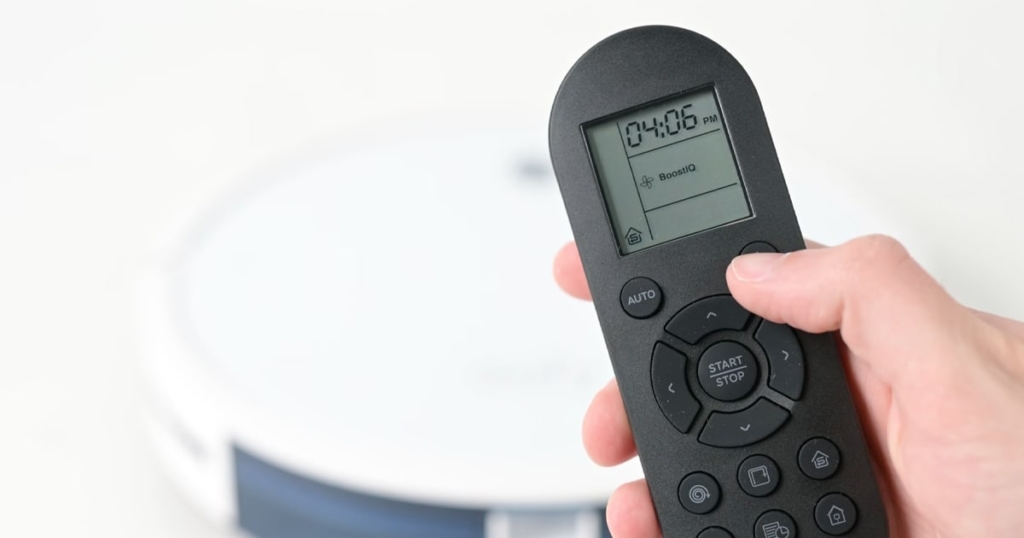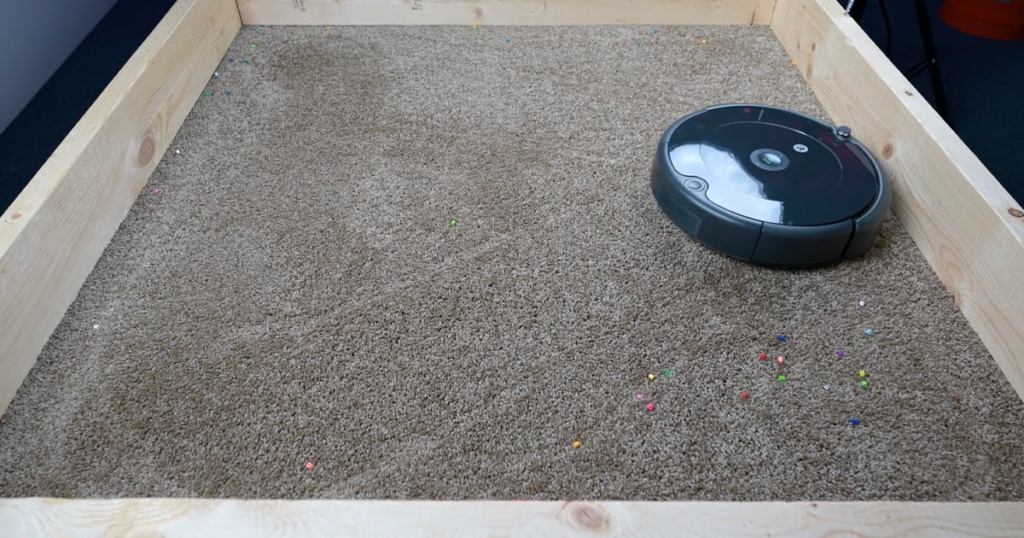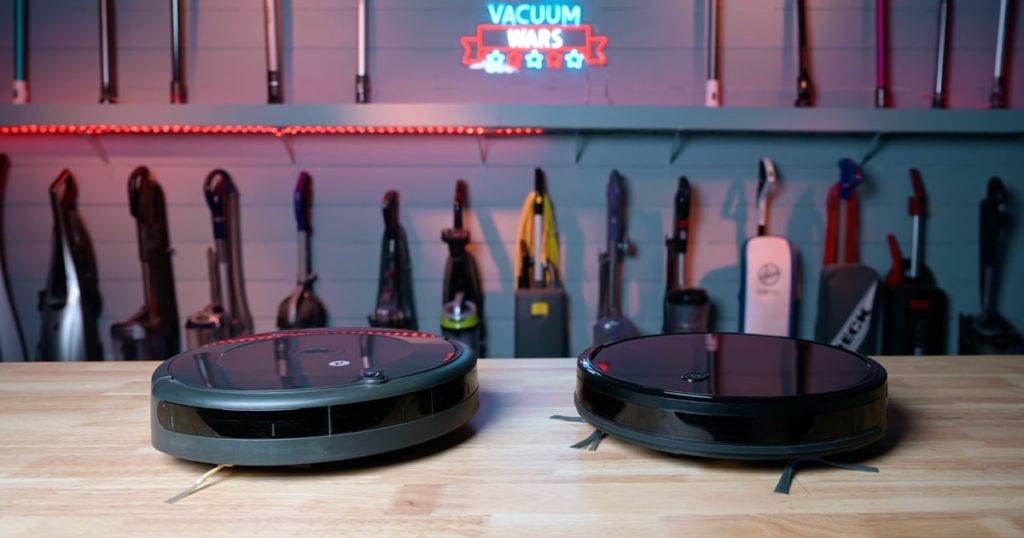In this robot vacuum comparison, we’ll look at two of the best-selling robot vacuums of all time: the Roomba 600 series, in this case, the Roomba 694, and the Eufy 11S.
These two robot vacuums are among the best budget robot vacuums you can buy with similar features, making them an excellent match for a head-to-head competition. We put them both through many tests over several weeks, and in this review, we’ll compare the results and see which one came out on top.
The iRobot Roomba 694 is a reliable and budget-friendly robot vacuum, perfect for smaller spaces without the need for advanced features. It excels in cleaning performance and durability, making it a great choice for those who want a dependable, no-frills vacuum.
- Reliable cleaning
- Solid performance
- Budget-friendly
- Good for small spaces
- Durable build
- No row navigation
- No self-emptying
- Limited features
- One power level
- Slim design
- Solid performance
- Budget-friendly
- Good under furniture
- Three power levels
- No app control
- Basic navigation
- Single brush roll
- No Dirt Detect
- Limited features
The first thing to be clear about is that these are budget robot vacuums. Neither have neat row-by-row navigation, sophisticated apps, or self-emptying bins. But, for smaller spaces, they do get the job done.
About the Roomba 694
iRobot’s Roomba 694 is one of the most successful robot vacuums the brand has ever released. It came out several years ago and, at the time, would likely be regarded as a midrange robot vacuum.
Due to its cleaning ability and solid overall performance, iRobot has continued manufacturing it, now selling it as a budget alternative to more sophisticated robot vacuums like the Combo j7+ and i3 and i7 models.
Overall, these high-performing budget robot vacuums are well-built and have stood the test of time. Both of them are best sellers for a reason.
About the Eufy 11S
Eufy’s 11S was the brand’s first hit robot vacuum. Like the Roomba, it is a bump-and-run robot that changes directions when encountering immovable objects. It cleaned well and tended not to get stuck like other robot vacuums. Eufy priced it competitively then and still sells the 11S today.
The S in the name stands for Slim, and the 11S can get beneath low furniture that other models might not. This Eufy 11S can often be found for under $150, meaning for the price of one Roborock S8 Pro Ultra, you could buy 10 Eufy 11S robots.
Features
App
The first round is all about features. One important feature that the Roomba has that the Eufy does not is an app. So while you can control the Eufy with its included physical remote, you can control the Roomba from your smartphone, even when you aren’t home, which is useful.

Dirt Detect and Brushroll Design
The Roomba also has Dirt Detect, allowing it to sense particularly dirty areas and spend more time cleaning them. Also, unlike the Eufy, the Roomba has a floating brush, which means that the housing of the brush roll moves to conform to the floor type. Something else unique to the Roomba is its patented dual brush roll design, which we’ll look at later.
Carpet Boost
One thing that the Eufy has that the Roomba does not have is three power levels, whereas the Roomba only has one. Those three power levels allow for something that Eufy calls Boost IQ, where, when it senses that it’s vacuuming carpet, it automatically boosts the power from low to high for better performance and battery optimization. The Eufy also has two side brushes, whereas the Roomba only has one, which makes it slightly better as a sweeper.

Adding up the scores for this round, the Roomba scored significantly higher than the Eufy.
Performance
Moving on to the performance category, we take into account the bench test that we do in the studio, like airflow and suction tests, but also a variety of pickup tests. When comparing the Roomba 694 vs Eufy 11S for picking up surface debris on hard floors and carpets, arguably the primary job of a robot vacuum, they were incredibly good.

Suction and debris pickup
Both robots picked up everything from fine to extra-large debris on both surface types with no noticeable difference between them. In our other bench tests, the Eufy had more raw power regarding suction and airflow, which was also evident in the crevice pickup test, where it scored much higher than the Roomba. However, while Roombas tend to score lower in suction and airflow, they still perform well on pickup and other carpet cleaning tests because of their patented dual brush roll design.

Carpet deep clean test
In the carpet deep clean test, where we embedded sand into medium pile carpet and weighed the bin before and after a set amount of passes, the Roomba scored higher than the Eufy and significantly above average. After adding up the totals for the performance category, the Eufy scored higher than the Roomba overall.
Navigation
The next category is navigation, where we give each vacuum several test runs and then have them clean a standardized floor plan in different modes and with different power settings where applicable. Because both of these are budget robot vacuums that don’t make a map of your home and therefore navigate more or less randomly, we had to score their navigation efficiency differently than usual.

Using visual information, we found that they were both virtually identical in how much area they covered per minute on average, with the Eufy scoring just slightly more than the Roomba, but within a margin of error. Although both vacuums could cover the entire area much better than expected, it took them a bit longer than a smart robot vacuum. While they could cover about 0.4 square meters per minute, the average smart robot vacuum can cover 0.64 square meters per minute.
Battery Efficiency
The battery efficiency test helps us understand how good their battery life is, which we do by taking average measurements of how much their battery depletes per square meter on different power settings. For example, we ran the Roomba on its only power setting, and we ran the Eufy three times on each of its power settings and took an average.

The Roomba had slightly better battery efficiency here, getting an average of 4.5 square feet per minute on the Roomba and 4.7 square feet per minute on the Eufy. As for coverage, the Eufy did slightly better in our tests. Again, however, take these numbers with a huge grain of salt because many variables can change them.
The navigation score totals were 84 to 82.
Roomba 694 vs Eufy 11S Conclusions
After adding up all the scores, the Roomba 694 barely beat the Eufy 11S, 168 to 150. However, the Roomba had more features and did better with navigation than the Eufy. And if you have carpets, you would likely prefer the Roomba 694 because of its carpet performance.
Overall, these high-performing budget robot vacuums are well-built and have stood the test of time. Both of them are best sellers for a reason.
Test Results
| Eufy 11S | Roomba 694 | |
|---|---|---|
| Suction (Max) | 0.86 kpa | 0.06 kpa |
| Airflow (Max) | 15 cfm | 9 cfm |
| Carpet Deep Clean Test | 70/100 | 86/100 |
| Navigation Efficiency Test | 0.4 m2/min | 0.4 m2/min |
| Battery Efficiency Test | 4.7 sq. ft./% | 4.5 sq. ft./% |
| Area per Battery Charge | 509 sq. ft. | 445 sq. ft. |
| Where to Buy | Amazon | Amazon |
- Reliable cleaning
- Solid performance
- Budget-friendly
- Good for small spaces
- Durable build
- No row navigation
- No self-emptying
- Limited features
- One power level
- Slim design
- Solid performance
- Budget-friendly
- Good under furniture
- Three power levels
- No app control
- Basic navigation
- Single brush roll
- No Dirt Detect
- Limited features




